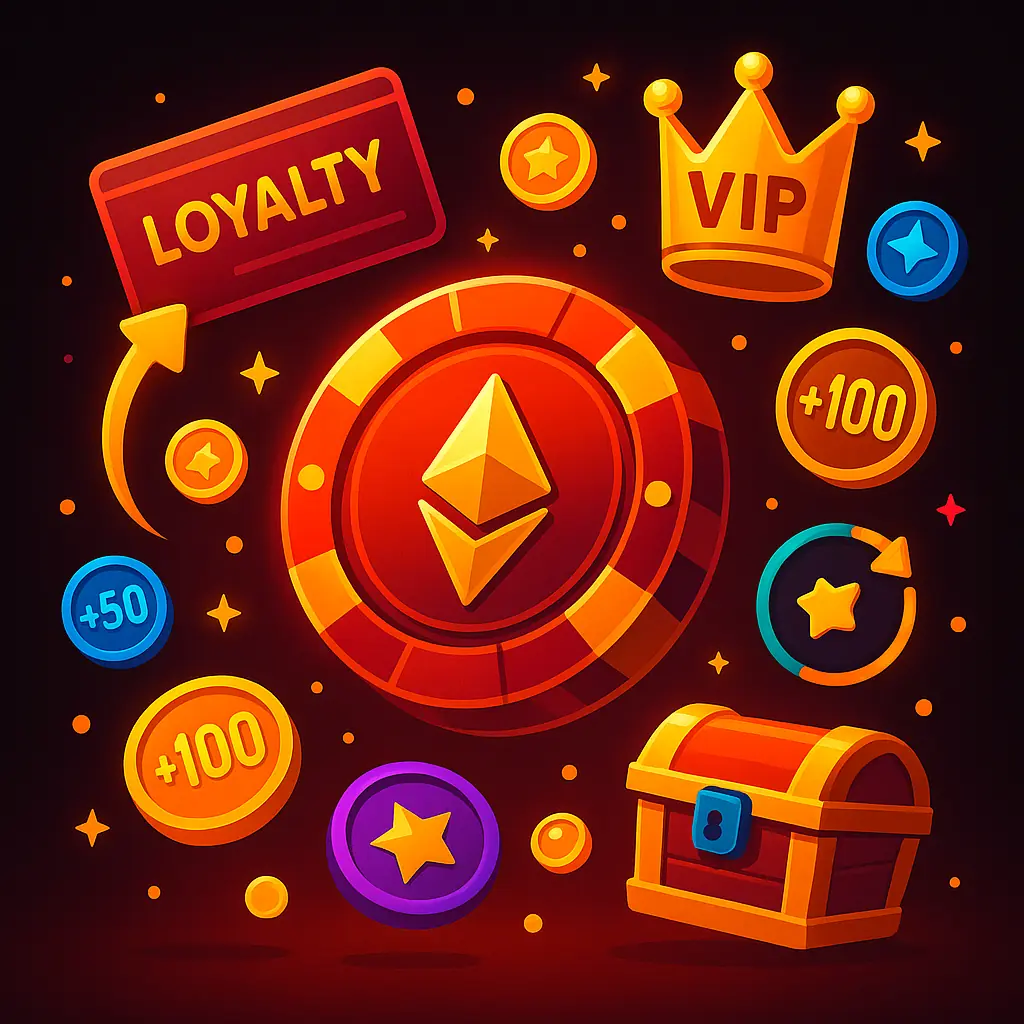If you’ve ever played at a casino — online or in Vegas — you know about loyalty rewards. You gamble, you earn comp points, and maybe you get free drinks or cashback.
But in Web3 casinos, loyalty takes a very different shape. Instead of just points on a balance, players earn tokens: real digital assets that can unlock rakeback, governance rights, or even profit-sharing from the house.
Let’s break down how casino tokens and loyalty rewards work in Web3, the real examples you should know, and why they matter for both players and degens looking for yield.
How Loyalty Works in Web2 vs Web3
Web2 casinos:
- Rewards are centralized.
- You get VIP tiers, cashback, free spins.
- Points are only usable inside that casino.
Web3 casinos:
- Rewards come in tokens recorded on-chain.
- Tokens have liquidity and can be traded.
- Loyalty is financialized: your rewards can appreciate, pay dividends, or unlock governance rights.
In short: Web2 loyalty = discounts. Web3 loyalty = ownership.
Real Examples of Casino Tokens
- RLB (Rollbit Token) → Players stake RLB to share in Rollbit’s casino and trading revenue. Became one of the hottest gambling tokens in 2023–24.
- BFG (BetFury Token) → Stakers get daily dividends in BTC, ETH, and USDT — straight from casino profits.
- DG & ICE (Decentral Games) → DG = governance token, ICE = play-and-earn token for their metaverse poker ecosystem.
- FUN (FunFair) → Early Ethereum-based gambling token, showed how casino ecosystems can tokenize rewards.
- CET (CoinEx Token) → Exchange token that doubles as a loyalty coin for casino-style products.
The Types of Loyalty Rewards in Web3
1. Token Rewards (Stake & Earn)
Many casinos reward loyal players with their native token. Holding or staking that token brings:
- Daily/weekly dividends from house revenue.
- Boosted rakeback and cashback.
- Exclusive VIP tiers.
Example: BetFury distributes millions in daily dividends to BFG stakers across multiple cryptos.
2. Rakeback in Real-Time
Web3 casinos often offer instant rakeback: a % of every bet returned immediately, usually in crypto.
- Stake.com → 5–10% rakeback for VIPs.
- Rollbit → Real-time rakeback tied to activity.
For regular players, this is often more valuable than welcome bonuses.
3. NFT-Based Loyalty
Some Web3 casinos use NFTs as loyalty passes:
- Decentral Games ICE Poker → Wearable NFTs act as buy-ins and give multipliers.
- Casinos experimenting with NFT VIP cards that unlock boosted rewards.
4. Jackpot Entries
Some platforms reward loyalty with automatic jackpot or raffle entries. The more you play, the higher your odds to win big side prizes.
5. Governance Rights
Owning a token can also mean voting power.
- DG holders vote on Decentral Games updates.
- Other DAOs experiment with governance for house edge distribution or new game launches.
Why Tokens Make Loyalty More Powerful
- They have real value. Unlike points in Web2, casino tokens can be traded or sold.
- They align incentives. If the casino grows, the token value can rise, rewarding loyal players.
- They make you a stakeholder. In some cases, you literally share in profits.
Example: In 2023, RLB holders saw the token 10x because Rollbit’s revenue surged. That’s a loyalty reward no Web2 casino can match.
Risks of Casino Tokens
Not all tokens are equal, fam. Some are gold, others are dust. Risks include:
- Volatility → Token price can dump, wiping out your rewards.
- Fake promises → Many tokens say “revenue share” but don’t actually distribute profits.
- Liquidity traps → Some coins trade on tiny exchanges with no real volume.
- Regulation → Tokens that share revenue could be flagged as securities.
Always check: is the token actually tied to revenue, or is it just hype?
Famous Scandals & Wins
- FunFair (FUN) pumped hard in 2017 but lost traction when adoption slowed.
- BetFury’s BFG has survived multiple cycles and still pays holders.
- Rollbit’s RLB went viral on X because stakers were literally earning a cut of casino profits — but it also showed insane volatility.
Numbers That Prove the Trend
- Global online gambling market = $90B+ in 2024, projected to hit $150B+ by 2030.
- Gambling tokens like RLB and BFG hit hundreds of millions in daily trading volume during peak hype.
- Casinos like Stake and Rollbit generate billions in revenue annually, making token-based loyalty potentially more lucrative than Web2 comp points.
The Future of Loyalty in Web3 Gambling
- Account abstraction will make earning tokens seamless for Web2 users (log in with email, get loyalty tokens without touching wallets).
- Cross-casino loyalty tokens could emerge — one coin usable across multiple platforms.
- Metaverse integration → NFTs that double as loyalty passes in poker rooms, slot machines, and sports betting lounges.
- DeFi + gambling fusion → Staked tokens earning yield both from house profits and lending protocols.
How to Maximize Loyalty in Web3 Casinos
- Focus on rakeback and dividends — the most consistent rewards.
- Stake only in casinos with volume + reputation (Rollbit, BetFury, Decentral Games).
- Treat tokens as high-risk — don’t hold more than you’re willing to lose.
- Look for audited contracts before staking in revenue pools.
Final Word
Casino tokens and loyalty rewards in Web3 are more than just perks. They turn players into stakeholders. Instead of just earning points, you can hold assets that pay you back, unlock VIP perks, and even rise in value.
They’re not risk-free. Token dumps, scams, and regulation can hit hard. But compared to Web2 comp systems, Web3 loyalty is next-level — blending gambling, DeFi, and community culture into one.
For players, it means more rewards. For degens, it means more ways to earn. And for the industry, it means loyalty isn’t just about playing — it’s about owning a piece of the action.
Wagmi 🚀


